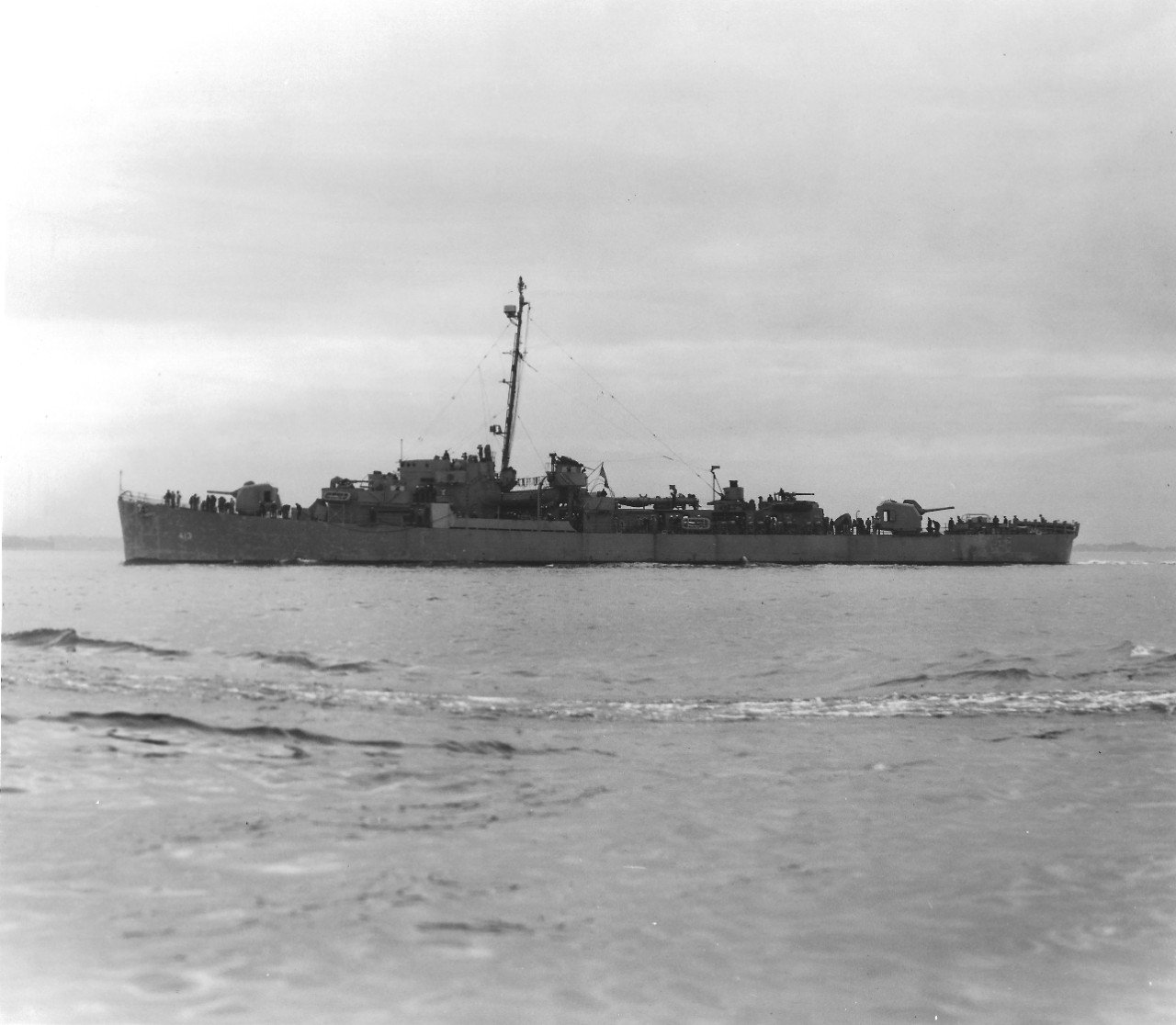
The story has been updated to correct the hull number for Oliver Hazard Perry-class guided-missile frigate USS Samuel B. Roberts (FFG-58).
The Navy confirmed the discovery of the wreckage site of destroyer escort USS Samuel B. Roberts (DE-413), which sunk in the Battle of Leyte Gulf in October 1944.
The remains of the ship were found off the Philippine coast, and the Navy now considers the site to be a “hallowed war grave.”
In confirming the discovery last week, retired Rear Adm. Samuel Cox, director of the Naval History and Heritage Command, said in a statement the destroyer escort’s wreckage was discovered at 6,895 meters by Victor Vescovo and his underwater technology company Caladan Oceanic and EYOS Expeditions.
Despite having half as many guns as destroyers, less than a third as many torpedoes and slower, the John C. Butler-class ship known as “Sammie B.” engaged three Japanese battleships, including Yamato, and two Japanese heavy cruisers.
These actions during the Battle of Samar by the much smaller American ships successfully protected the U.S. invasion force in its landings at Leyte Gulf against the counter-attacking Japanese fleet. Eighty-nine crew members of Samuel B. Roberts died in the battle. Its commander, Lt. Cmdr. Robert Copeland, said 120 men were rescued.
“The gallantry of her crew serves to inspire U.S. Navy personnel today,” Cox said in the statement.
After the Navy’s confirmation of the wreckage as being that of “Sammy B.,” Vescovo, a retired naval officer said, “I always remain in awe of the extraordinary bravery of those who fought in this battle against truly overwhelming odds – and won” at the Battle of Samar, the last phase of the naval combat in the Battle of Leyte Gulf. Leyte Gulf is often considered the largest naval engagement in history.
The destroyer escort was laid down in Texas in December 1943 and named for coxswain Samuel B. Roberts, who received the Navy Cross posthumously for his actions at Guadalcanal.
A plaque commemorating the crew of DE-413 was aboard the Oliver Hazard Perry-class guided-missile frigate USS Samuel B. Roberts (FFG-58) when the ship struck a mine in the Persian Gulf in April 1988 that blew a 15-foot hole in the ship. With the keel broken, the crew struggled for five hours to purge water and fight fires to save the vessels.
The plaque is now at the National Museum of the United States Navy in the Washington Navy Yard.
This is the deepest shipwreck ever recorded, surpassing the depth of USS Johnston (DD-557), which was also sunk in the Battle of Samar, and discovered by Vescovo last year.
As was the case last year, all the data – including sonar maps, videos and photographs – will be donated to the Naval History and Heritage Command.
Vescovo, with sonar specialist Jeremie Morizet of France, piloted submersible Limiting Factor. They discovered the wreck resting on a slope. It was broken into two pieces that were separated by about 10 meters.
Kelvin Murray, EYOS director of expedition operations and undersea projects, said in a statement that “using a combination of detective work and innovative technology, everyone has pulled together to reveal the final resting place of this tenacious ship.”
The search for “Sammie B.” and escort carrier USS Gambier Bay (CVE-73) began June 17. Debris from a three-tub torpedo launcher from the destroyer escort was positively identified the next day, but the main wreckage site was not found until later that week.
According to an EYOS news release, the search also used a Kongsberg EM-124 deep-ocean ship-mounted sonar for bathymetry and backscatter analysis. It employed a first-of-its-kind submersible-mounted sidescan sonar built for Caladan by Deep Ocean Search, a French firm, and a shorter-range Kongsberg Mesotech 1,000 high-frequency sonar.
During the search, which lasted through June 24, the team made two dives searching for Gambier Bay, which was also sunk in the battle. The searches were inconclusive “due to the scarcity and unreliability of data” indicating where the carrier went down and time limitations, according to the EYOS release.
Caladan and EYOS will return to Guam to begin further expeditions in the Western Pacific, including four planned dives at Challenger Deep to continue explorations there. Vescovo bested the depth record set by the Navy’s deep-sea Trieste in an earlier expedition to the Mariana Trench.





